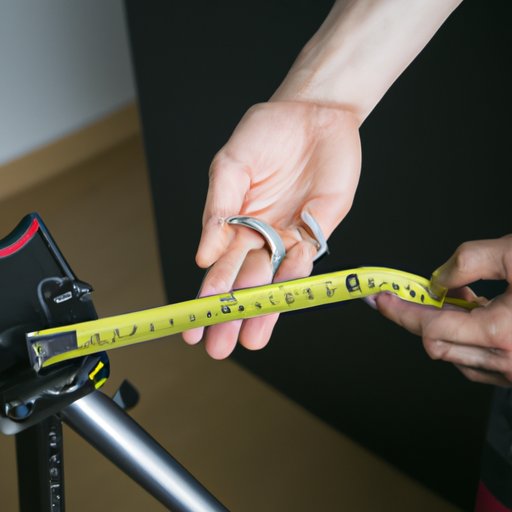Introduction
Bike size is an important factor to consider when purchasing a new bike. It affects the comfort, safety, and overall performance of the rider. In order to get the right size bike, it is necessary to measure for bike size before making a purchase. This article will provide a step-by-step guide on how to measure for bike size.
Measure Your Inseam Length
The first step in measuring for bike size is to measure your inseam length. This measurement will determine the size of the frame you need. To measure your inseam length, stand with your feet slightly apart and place a book or ruler between your legs. Make sure the book or ruler is placed horizontally and is parallel to the floor. Measure the distance from the top of the book or ruler to the floor. This is your inseam length. You can also use a tape measure for a more accurate measurement.
In addition to your inseam length, there are other measurements that you should take into consideration when measuring for bike size. These include your height, weight, arm length, and torso length.
Determine the Size of Bike Frame You Need
Once you have measured your inseam length, you can use this measurement to determine the size of bike frame you need. Generally speaking, the taller you are, the larger the frame you need. If you are under 5’5″ (165 cm) tall, you will likely need a smaller frame. Conversely, if you are over 6’0″ (183 cm) tall, you will likely need a larger frame. Additionally, if you are heavier than average, you may need a larger frame to accommodate your weight.
It is important to note that frame sizes are not always consistent across different bike brands. Some brands may have larger frames than others, so it is important to consult the manufacturer’s size chart before making a purchase.

Consider Your Riding Style and Body Type
In addition to your height and weight, it is important to consider your riding style and body type when measuring for bike size. Different types of bikes are designed for different types of riding styles. For example, mountain bikes are designed for off-road riding, whereas road bikes are designed for on-road riding. Depending on the type of riding you plan to do, you may need a different size frame than what is recommended for your height and weight.
Your body type is also an important factor to consider when measuring for bike size. If you have longer legs or shorter arms, you may need a different size frame than what is recommended for your height and weight. Additionally, if you have a wider or narrower torso, you may need a different size frame than what is recommended.

Try Out Different Bikes with the Same Frame Size
Once you have determined the size of frame you need, it is important to try out different bikes with the same frame size. Even if two bikes have the same frame size, they may feel different due to different components such as handlebars, seat posts, and cranksets. By trying out multiple bikes with the same frame size, you can determine which one feels most comfortable for you.
When testing out different bikes with the same frame size, it is important to pay attention to how the bike fits your body. Make sure the handlebars are not too wide or narrow, and make sure the saddle is at the correct height. Additionally, make sure the crankset is at the correct distance from the ground. All these factors will affect the comfort and performance of the bike.

Have a Professional Bike Fitter Assess Your Needs
Finally, it is beneficial to have a professional bike fitter assess your needs. A professional bike fitter can help you find the perfect fit for your body type and riding style. They will take into consideration your height, weight, body type, and riding style, and they will be able to recommend the best frame size and components for your needs.
Having a professional bike fitter assess your needs can help ensure that you get the most out of your bike. They will help you find the most comfortable and efficient fit, which will help you ride faster and further.
Conclusion
Measuring for bike size is an important part of purchasing a new bike. It is important to measure your inseam length and determine the size of frame you need based on your height and weight. Additionally, it is important to consider your riding style and body type when selecting a bike size. Furthermore, it is beneficial to try out different bikes with the same frame size to find the most comfortable fit. Finally, it is highly recommended to have a professional bike fitter assess your needs to ensure the perfect fit. Taking the time to measure for bike size can make all the difference in your cycling experience.


